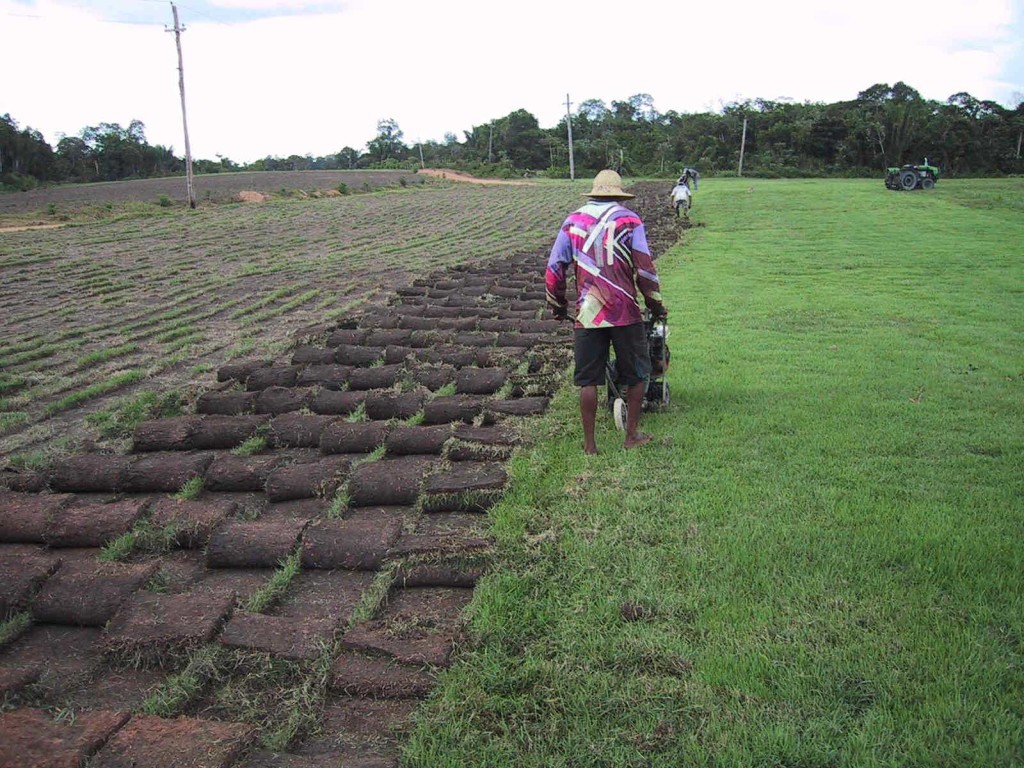Lessons from the Ancients
By Amanda Fortier

Senegalese Farmers Help Break Ground in Agricultural Development. Amanda Fortier reports from Dakar.
On every continent there is a history of man that begins with the land. Through time and trial the lessons reaped from the soil were passed down to sustain the rise and succesion of each passing generation.
In North America the native Indians discovered a magical combination of three crops – corn, squash and beans – that when planted together on a small mound of dirt would not only nurture the earth beneath them with the exact nutrients it needed to stay fertile, but would help each other along in the growing process. The corn would be the mast to which the bean vines could climb, the roots of the squash would prevent water loss in the soil beneath them, and the beans would capture the nitorgen from the air to return to the soil to feed the corn – a crop that when planted alone depletes the soil of its vital nitrogen. In present day, when studied by scientists, it was discovered that the three crops when eaten together provide the exact amount of amino acids needed to build one protein in the human body. The native Americans called this garden “The Three Sisters”.
Today most of society is disconnected from the land, and reliance on a globalized food chain which provides food to mass populations by commercially farming one crop over vast stretches of land, has brought many people away from the secrets of our ancestors.
In light of threats on global food security and the widespread incidences of soil degradation worldwide, there is a serious movement to return to ancient farming practices as a way to revitalize our land and to put power back into the hands of the individual as a direct means of sustenance. Senegal-based journalist Amanda Fortier reports on one such initiative being tested in the unforgiving soil of sub-Saharan Africa.
Over seventy kilometers northeast of Senegal’s capital city, Dakar, is a long stretch of highway dotted with sprawling baobab trees leading close to the village of Keur Madaro in the region of Thiès.
Like most parts of this Sahelian country, the land here is mostly dry and dusty. Day after day the African sun beats down its prickling rays. Bursts of hot wind scoop fistfuls of sand off up the ground and the earth seems to cry back in pain. It’s hard to imagine how shrubs survive in this brittle soil, let alone an entire harvest of leafy green vegetables thriving under such hostile conditions.
Since June 2009, a new agricultural initiative was introduced into this small West African country. The project is a joint collaboration between the international NGO Pro-Natura and the France-based social business JTS Seeds. Together they came up with the concept of Super Vegetable Gardens (or Jardin Tropicale Amélioré). SVG is an innovative growing method that was researched for the last thirty years and began testing in the fields of Niger in 2007.
In Keur Madaro, there are ten SVG’s and well over a hundred more scattered throughout the country. While still in its early stages, SVG tries to address issues of food security, poverty reduction and climate change in Africa. If successfully adopted, the project could potentially revolutionalize the agricultural sector on the continent and eventually help other smallhold farmers in tropical zones across the globe.
Francois Sarr is a thirty-year old Senegalese who started his first of two SVG’s last October. He was sponsored by the local aid group, Sénégalité. Each SVG garden is grown on a sixty square meter plot of land and starts with a single kit, something of a toolbox for farmers. Inside is a selection of non-GMO vegetable seeds, soil amendments such as fertilizers, and growing equipment – much like piece of furniture would arrive from IKEA waiting to be assembled.
Over the first five days, Sarr learned the planting techniques. First, he was shown how to crack through the cement-like soil and bury seeds deep into the ground. Then they used water retention sponges to prevent water runoff and soil erosion, and draped long plastic veils over the plants for protection.
For new SVG gardeners, they must take either two or five day technical training sessions to learn this growing method. The kit costs 149 euros and another 300 euros for the instructions and follow-up visits. With the average salary in Senegal hovering around $2 a day, the current cost of SVG’s is beyond most people’s means.
Sarr planted his first harvest on October 5th, 2009. Forty-five days, he gathered an enormous crop overflowing with cucumbers, beets and eggplants. The total weight came to nearly 200 kilograms.
“I couldn’t believe it,” says Sarr. “My first harvest, and I made way more than my family could eat. There are only seven of us, so we sold the rest and made just over $150.
For most farmers, stories of this kind seem too good to be true. In Senegal, like throughout the continent, farming forms the backbone of the economy. Agriculture employs over seventy percent of the population. But farmers have been particularly vulnerable to the effects of climate change. Rises in temperatures and erratic rainfalls have lowered crop productivity. Food insecurity and malnutrition is widespread.
Guy Reinaud, President of Pro-Natura, explains, “While the project is developing like wildfire, the only obstacle is linked with the kind of person taking care of the garden.”
Farmers must work on their garden for two hours a day. This is usually done in the early mornings, between 7 and 9 am.
“It’s mainly the women who are capable of this discipline,” believes Reinaud. “Men usually over-water their cops, because they only work the topsoil.”
When too much water is used, it actually lowers productivity. The moisture never reaches the seeds and ends up pushing nutrients away from the soil.
Using sponges and plastic lining has allowed farmers like Sarr to use eighty percent less water, a savings of about 600 liters a day. This is a huge amount in a country where they depend on rainfall and only five percent of the land is irrigated.
Senegal is a relatively prosperous country compared to the rest of Sub-Saharan Africa. The Food and Agriculture Organization of the United Nations estimates there are almost 265 million people in Sub-Saharan Africa who suffer from chronic hunger. In Senegal, just over sixty percent of the population don’t eat enough calories every day. Even if food could be distributed, there just simply isn’t enough to go around.
Moda Gueye is director of JTS Senegal. He says, “It’s great to talk about food quality, but today there are still people dying from hunger in this country.”
“We can do both,” he admits, “we can produce more food than traditionally, but we can also make it better quality.”
Another innovative part of the SVG project, but one still in experimentation, is the use of biochar. The charcoal powder has been dubbed “black gold agriculture”, or “green charcoal”. It was developed over 7,000-years ago in the Amazonian rainforest under its local Brazilian name, Terra Preta. It’s used as a powerful soil amendment, and among agriculturalists and academics, biochar is the hot new topic.
Making biochar is fairly simple. Agricultural residues, like cotton stems and rice husks, are burned without oxygen to produce an organic biomass that has two times the amount of carbon as regular wood-produced biomass. When combined with organic compost and applied to the soil, the mixture produces a richly colored earth that is soft and spongy to touch. It’s the stuff that farmers in any country dream of.
Biochar has the potential to increase crop productivity, reduce water consumption and even act as carbon sinks that absorb and store carbon dioxide from the atmosphere.
Whether it’s an agricultural panacea though, is still too early to say.
Dr. Johannes Lehmann is one of world’s leading experts on biochar and associate professor at Cornell University’s faculty of soil fertility management and soil biogeochemistry. He has been studying the efficacy of biochar in African and South American soils for over ten years and cautions that “biochar is not a magic bullet”.
“Biochar has been shown to address certain soil fertility constraints, but not all of them,” Lehmann explains. “Farmers should only be involved with biochar at this point if they realize they’re at the frontier of experimentation and that they’re generating new information when they do that.”
In Africa particularly, where wood is still the main energy source, alternate fuel supplies must be made available. Biochar could help solve this problem, but for the next year it’s still in testing phase in the Thiès region.
As the 2015 deadline for reaching the Millennium Development Goal fast approaches, there are still many hurdles to meet even the first goal of eradicating extreme poverty and hunger. Since the recent food crisis and global economic recession, the overall number of under-nourished has actually increased. If there isn’t more investment in food security through developments in agriculture in Africa, the International Food Policy Research Institute says this could push another 16 million into malnutrition.
There is no doubt farmers in the developing world must find new ways of sustaining their food crops, while minimizing their losses.
Reinaud says there’s very little money for innovation, but they’re still moving forward. SVG’s have since been introduced into Algeria and Egypt and are planned for Haiti in May.
But without better access to information on climate and to new crop technologies and techniques, many farmers are left with little option. Among the Senegalese young people, in particular, it’s difficult to encourage them to take up agriculture.
“A country where in ten to fifteen years no one grows anything will be a catastrophe on an economic and social level,” says Gueye. “In the villages, the kids tell me they’d rather get on a boat to flee to Europe. They tell me here they are already dead, because here they have nothing.”
For young farmers like Sarr, they are the real-life examples of how SVG could not only help revitalize the land and provide adequate and proper nutrition, but also restore the dignity and pride of a population that quite literally lives off the land.
